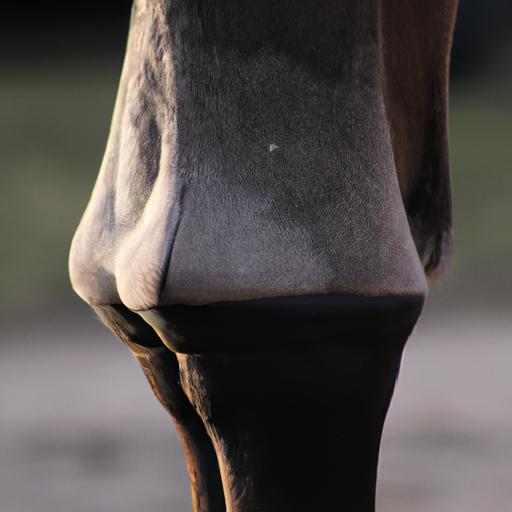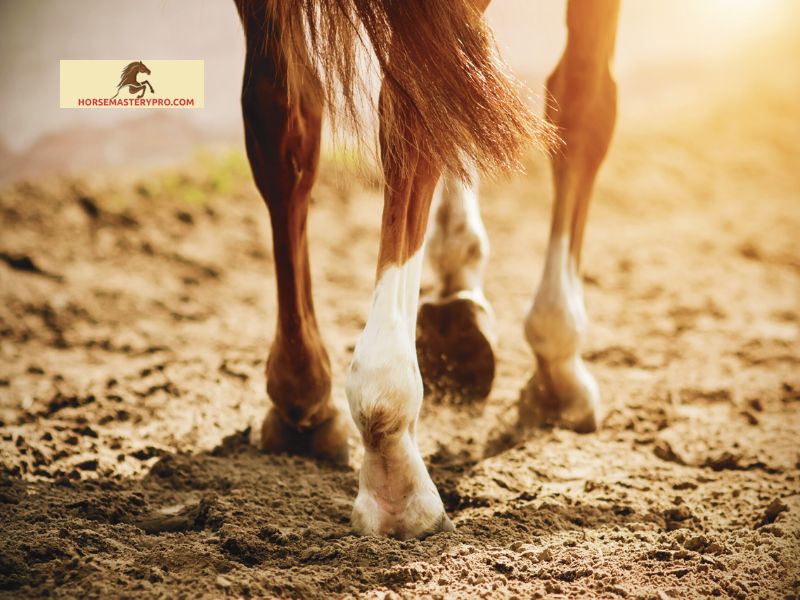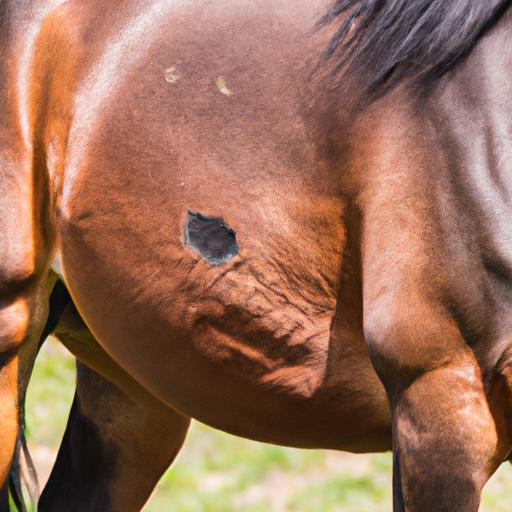Uncover the hidden risks of capped hocks in horses. Learn about infections, chronic conditions, and the impact on horse performance and welfare.
Introduction to Capped Hocks in Horses

When it comes to our equine companions, we always strive to ensure their well-being. However, as horse owners, we may encounter certain conditions that require our attention and understanding. One such condition is capped hocks in horses. In this article, we will delve into the world of capped hocks, shedding light on their definition, causes, and risk factors.
A. Definition and Overview of Capped Hocks
So, what exactly are capped hocks? Capped hocks refer to the swelling or enlargement that occurs at the point of the hock, the joint that connects a horse’s hind limb to the cannon bone. The condition is characterized by a soft, fluid-filled sac that forms beneath the skin, causing discomfort and potential mobility issues for our equine friends.
B. Common Causes and Risk Factors
Understanding the causes and risk factors associated with capped hocks is crucial for effective prevention and management. One of the primary causes is repeated trauma to the hock joint, often resulting from excessive kicking or striking against hard surfaces. Additionally, poor stable conditions, such as inadequate bedding or confinement in small spaces, can contribute to the development of capped hocks.
Certain factors increase the risk of horses developing capped hocks. Athletes engaged in high-impact activities like racing or jumping are more susceptible due to the repetitive strain on their hock joints. Moreover, horses with conformational faults, such as sickle hocks or cow hocks, may experience added stress on their hocks, making them prone to developing this condition.
As responsible horse owners, it is essential to be aware of the causes and risk factors associated with capped hocks. By gaining a comprehensive understanding of this condition, we can better equip ourselves to address and prevent it, ensuring our horses’ comfort and overall well-being.
Stay tuned for the next section, where we will explore the symptoms and diagnosis of capped hocks in horses, enabling us to detect and address this condition promptly.
Symptoms and Diagnosis of Capped Hocks

A. Identifying the Signs of Capped Hocks
Recognizing the signs of capped hocks is crucial for early detection and timely intervention. Keep a keen eye out for the following indicators:
- Swelling: Capped hocks are characterized by visible swelling or enlargement at the point of the hock joint. This swelling may initially appear soft and fluid-filled, gradually becoming firmer over time.
- Heat and Pain: If you notice your horse’s hock feeling warm to the touch or displaying signs of discomfort, such as sensitivity when pressure is applied, it could be an indication of capped hocks.
- Limited Range of Motion: Observe your horse’s movement closely. If you notice stiffness or a reduced range of motion in the affected hock joint, it may be a sign of capped hocks.
B. Steps for Diagnosing the Condition
When it comes to diagnosing capped hocks, it is essential to involve a qualified veterinarian. They will perform a thorough examination and may recommend further diagnostic tests to confirm the condition. Here are the typical steps involved in diagnosing capped hocks:
- Physical Examination: The veterinarian will visually assess the swelling and examine the affected hock joint, taking note of any pain or discomfort experienced by the horse.
- Palpation: By gently palpating the hock, the veterinarian can identify the presence of fluid-filled sacs and determine the extent of the swelling.
- Imaging: In some cases, the veterinarian may recommend imaging techniques such as X-rays or ultrasound to assess the underlying structures, rule out other potential causes, and evaluate the severity of the condition.
Remember, early diagnosis is essential for effective treatment and management of capped hocks. By promptly involving a veterinarian and following their guidance, we can ensure the well-being of our equine companions. In the upcoming section, we will explore the various treatment options available for horses with capped hocks, providing insights into both conservative and medical interventions.
Treatment Options for Capped Hocks in Horses

When it comes to treating capped hocks in our beloved horses, a combination of conservative methods and medical interventions can help alleviate discomfort and promote healing. Let’s explore the various treatment options available:
A. Conservative Treatment Methods
- Rest and Limited Exercise: One of the primary steps in managing capped hocks is providing ample rest to the affected horse. Limiting excessive movement and exercise allows the hock joint to heal and reduces the risk of further aggravation. Consult with your veterinarian to determine the appropriate duration of rest required for your horse’s specific condition.
- Cold Therapy and Compression: Applying cold therapy, such as ice packs or cold water, to the affected area can help reduce inflammation and swelling. Additionally, the use of compression bandages can provide support and aid in the healing process. Remember to follow proper techniques and consult your veterinarian for guidance on the frequency and duration of cold therapy and compression.
B. Medical Interventions
- Topical Medications and Ointments: Topical treatments, such as anti-inflammatory creams or ointments, can be effective in reducing inflammation and providing relief for mild cases of capped hocks. These medications are typically applied directly to the swollen area and should be used as directed by your veterinarian.
- Steroid Injections: In more severe cases, where conservative methods may not yield the desired results, your veterinarian may recommend steroid injections. These injections help reduce inflammation and promote healing. It is crucial to consult with your veterinarian to determine the appropriate dosage and frequency of steroid injections, as they should be administered under professional supervision.
Remember, treatment options may vary depending on the severity of the condition and the individual needs of your horse. It is essential to work closely with your veterinarian to develop a tailored treatment plan that considers your horse’s overall health and specific requirements.
In the upcoming section, we will discuss preventive measures that can help minimize the risk of capped hocks in horses, ensuring a healthier and happier equine companion.
Preventive Measures for Capped Hocks
Prevention is always better than cure, especially when it comes to the well-being of our beloved horses. To minimize the risk of capped hocks, implementing preventive measures is essential. Let’s explore some effective strategies to keep our equine friends free from this condition.
A. Proper Stable and Bedding Management
The first step towards prevention is ensuring a suitable environment for our horses. Proper stable and bedding management plays a crucial role in minimizing the risk of capped hocks. Providing ample space and ensuring well-padded stalls can help reduce the chances of trauma and injury to the hock joints. Additionally, using quality bedding materials that offer cushioning and absorbency will contribute to a comfortable and safe resting area for our horses.
B. Exercise Routines and Surfaces
Regular exercise is vital for our horses’ physical and mental well-being. However, it is equally important to consider the impact of exercise routines and surfaces on their hock joints. Varying exercise routines and incorporating low-impact activities, such as walking and trotting, can help alleviate excessive strain on the hocks. Additionally, choosing suitable surfaces, like well-maintained arenas or soft footing, can minimize the risk of trauma and reduce the chances of developing capped hocks.
C. Regular Inspections and Hygiene Practices
Proactive monitoring and regular inspections are key to preventing and addressing any potential issues promptly. Routinely check your horse’s hocks for any signs of swelling or irregularities. By detecting early warning signs, you can take immediate action and seek veterinary advice if necessary. Furthermore, maintaining proper hygiene practices, including regular cleaning and disinfection of stable areas, can help prevent infections and minimize the risk of complications associated with capped hocks.
By implementing these preventive measures, we can significantly reduce the likelihood of our horses developing capped hocks. Remember, a little extra effort in providing a safe and comfortable environment can go a long way in safeguarding our equine companions.
Stay tuned for the upcoming section, where we will delve into the complications and potential risks associated with capped hocks in horses.
Conclusion: Managing and Treating Capped Hocks Effectively
In conclusion, understanding and addressing capped hocks in horses is crucial for their overall well-being and performance. By being aware of the symptoms, diagnosis, and treatment options discussed in this article, you can take proactive measures to ensure your horse’s comfort and prevent complications.
Recalling the key points we covered, recognizing the early signs of capped hocks and seeking prompt veterinary diagnosis is essential. With conservative treatments like rest, cold therapy, and compression, you can alleviate discomfort and promote healing. In more severe cases, medical interventions such as topical medications or steroid injections may be necessary.
Prevention plays a vital role in managing capped hocks. Implementing proper stable management practices, providing suitable bedding, and ensuring appropriate exercise routines and surfaces can help reduce the risk of developing this condition. Regular inspections and maintaining good hygiene practices are also essential for early detection and intervention.
It is important to note that complications can arise if capped hocks are left untreated. Infections and abscess formation can occur, leading to further discomfort and potential long-term damage. Additionally, recurrence and the development of chronic conditions can impact your horse’s performance and overall welfare.
At horsemasterypro.com, we prioritize the well-being of our equine companions. By staying informed, seeking professional guidance, and implementing preventive measures, we can effectively manage and treat capped hocks, ensuring our horses lead healthy and fulfilling lives.
Remember, your horse’s comfort and well-being are in your hands. Stay vigilant, take action, and provide the care they deserve. Together, let’s create a world where capped hocks in horses are a thing of the past.
Note: horsemasterypro.com


